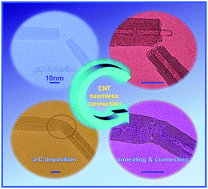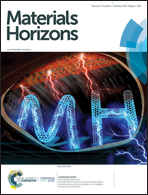Seamless interconnections of sp2-bonded carbon nanostructures via the crystallization of a bridging amorphous carbon joint†
Abstract
Two multiwalled carbon nanotubes (MWNTs) were seamlessly connected via the crystallization of a bridging amorphous carbon (a-C) joint using a transmission electron microscope. Technically, such a CNT connection involves electron beam induced deposition of amorphous carbon at the gap between the two nanotubes, followed by a controlled Joule heating process. Upon heating, the deposited a-C crystalized into a multi-layer tubular structure that merges into open-ended CNT shells, forming continuous graphitic layers across the junction. For the first time, seamless repairing of a pure MWNT after its electrical breakdown is thus achieved, accompanied by the nearly full recovery of its electrical conductance. More generally, we demonstrated its usage in the seamless joining of any two nanotubes, regardless of their difference in diameter, chirality, shell number and axis orientation. Molecular dynamics calculations reveal more details on how the a-C joint evolves into coherent sp2-bonded networks connecting the given nanotube pairs, thus highlighting the unique ability of the C system to reconstruct itself into any required sp2 graphitic configuration at high temperature. This seamless-joining method can be further extended to the connection between nanotubes and graphene, exhibiting its particular technological importance for building novel sp2 carbon-based nanostructures and devices via the bottom-up approach.

- This article is part of the themed collection: International Year of the Periodic Table : Low Dimensional Carbon Systems


 Please wait while we load your content...
Please wait while we load your content...